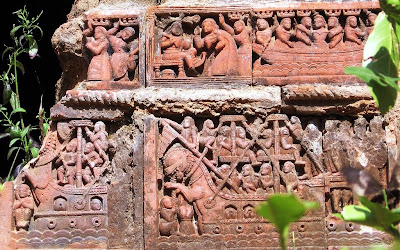Source : Panels on temples of Bengal and Rajasthan
Many of the surviving temples of India , built during medieval ages , are adorned with sculptures and panels . There is one common point : gods , goddesses, ‘yakshas’ and ‘yakshees’ are positioned at a height and the devotees have to look up to view them. Most of them are in static postures .
At the lower level, are panels, often overlooked by the tourists in a hurry, where one can view portrayals from scenes from life . In many of these panels we find the incumbents frozen in time, yet dynamic in postures.These panels are often not done to artistic perfection, but, most of these panels tell viewers stories about lives of common people and aristocracy of those days. A serious student of terra cotta art would have read Zulekha Haq's book where she has made a powerful presentation on social scenes in terra cotta temples of Bengal.
There is another reason why we were serious about these panels, While the sculptures at the higher levels are regal and beautiful, the postures are often static and can be monotonous. Artists created the eventful panels in lower level where often we found energy and the flow of life.
Here is a selection from photographs of such panels Ruby and I have taken during our trips to temples of Hooghly and Bankura districts of West Bengal as well as of Rajasthan and created 'albums' during last 3 years.

‘HUNTERS’: View the dynamics of all the human and animal figures of this panel. One of the oldest from my collection. 1648 AD. ’Jor-Bagla’ temple, Bishnupur, West Bengal.
 ‘MARCH TO THE BATTLEGROUND’: Movement of human and animal figures depicted with careful details. The Foot soldiers have differing strides. ’Sameedheswar Shiva’ temple, Chittorgarh, Rajasthan.
‘MARCH TO THE BATTLEGROUND’: Movement of human and animal figures depicted with careful details. The Foot soldiers have differing strides. ’Sameedheswar Shiva’ temple, Chittorgarh, Rajasthan.

‘TRAPEZE’ : A wonderful collage of 20 persons in various postures of acrobatics,The ‘zamindar’, in a crouching posture (LH bottom-most corner) watches the show. 1786AD.’RadhaGovindjiu’s temple, Aantpur, Dt –Hooghly, West Bengal.
 ‘COAXING’ : Woman sulks and looks away from his lover while their friends are in a mood of joyous revelry.1652 AD. ’Jagdhish’ temple. Udaipur, Rajasthan.
‘COAXING’ : Woman sulks and looks away from his lover while their friends are in a mood of joyous revelry.1652 AD. ’Jagdhish’ temple. Udaipur, Rajasthan.

‘FESTIVITY’ : Ecstasy and abandon .11th (?) century. ‘Aadinath’ temple, Ranakpur, Rajasthan.

‘FERTILITY’ : Queen Devaki rests on a upturned cane container (‘dhaamaa’ in Bengali) as her attendant helps her to give birth to infant Krsna. In the neighbouring panel, Mahamaya looks on while the lone sentry of Kansa’s prison dozes off. Vasudev will escape the prison in a short while with infant Krsna to take him to Vrindavan. 18th century .Krsna temple, Bahirgarh,
Dt.- Hooghly, West Bengal.

‘SAILING ON THE BROOKS OF LIFE’ : 18th century. Temple at Kotalpur, Dt.- Hooghly, West Bengal.
On the left-hand side, we find 4 milk-women of Vrindavan, stranded on the shore of Mathura,since Krsna has managed to disperse all the boatmen of the Yamuna river.2 women are seen to persuade Krsna to take them to take them to Vrindavan while the other two enliven the scene by song and dance.On the right-hand panel, we find Krsna in multiple manifestations.He is at the stern as well as at the centre of the boat,embracing Radha and another milk-woman.
On the lower level,we can see a large see a large boat, very European in its appearance. Damaged it is ..... but, it is not difficult to imagine how magnificent the panel was. Rows of sailors and revelers adorn the panel.


















